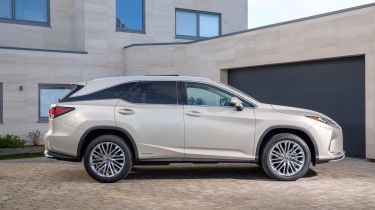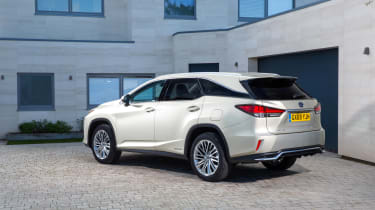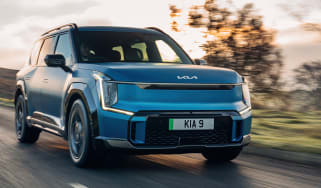Lexus RX L 450h (2018-2022) review
The Lexus RX L 450h adds an extra two seats and a larger boot, making the SUV even more appealing for large families

Pros
- Seven-seat practicality
- Smooth and refined
- High-quality interior
Cons
- A bit bland to drive
- Poor infotainment system
- Space is limited in seven-seat mode
| Car type | Fuel economy | CO2 emissions | 0-62mph |
|---|---|---|---|
| Hybrid | 34mpg | 185-186g/km | 8.0s |
When Lexus launched the RX in 1998 – under the name Toyota Harrier in Japan – it created one of the world’s first premium crossovers. It went on to enjoy considerable success, especially in the US, and some 2.7 million units have been sold worldwide across four generations. As a luxury SUV, the RX competes with the likes of the BMW X5, Volvo XC90, Mercedes GLE and Audi Q7, but the RX L offers an extra pair of seats.
This generation of RX L, discontinued in late 2022, is a ‘self-charging hybrid’, with a pair of electric motors on hand to improve fuel economy, lower CO2 emissions and deliver very short bursts of zero-emissions driving. Unlike some of its plug-in hybrid rivals, there are no charging cables and no chance of completing your daily commute in electric mode – unless you live a mile from your office.
The seven-seat RX L is available with one powertrain: a 3.5-litre V6 petrol engine mated to a pair of electric motors – one on the front and one on the rear axle. Total output is 308bhp, delivering a 0-62mph time of eight seconds and a top speed of 112mph.
The range kicks off with an entry-level model that gets a 12.3-inch multimedia touchscreen, six USB ports, smartphone integration via Apple CarPlay or Android Auto, the Lexus Safety System+ active safety package, a powered tailgate, a wireless smartphone charger, Tahara synthetic leather upholstery and eight-way power-adjustable front seats with two-way lumbar adjustment on the driver’s seat.
The standard specification can be upgraded with a 'Premium Pack', which adds smooth leather upholstery, front-seat heating ventilation, hands-free tailgate operation with a kick sensor, a heated steering wheel, auto-dimming and reverse-tilting functions for the door mirrors and an auto-retracting seat and steering wheel (with memory function).
At the top of the range, the RX L Takumi gets power-folding heated rear seats, a 15-speaker Mark Levinson stereo, a colour head-up display, 360-degree camera, semi-aniline leather upholstery, 10-way powered front seat adjustment, memory settings for the front seats, steering wheel and door mirrors. The RX L Takumi can also be ordered in a six-seat layout, with two individual 'captain's chairs' in place of the regular three-seat second-row bench.
The RX L is 110mm longer than the standard RX, with the extra length found in the bodywork at the back. At 5,000mm, the RX L is the same length as a Range Rover, but the ‘origami’ design language makes it one of the most striking family SUVs on the market.
From the front of the car to the rear wheels, the design is the same as the standard RX, but the steeper angle of the tailgate window creates the extra space required for the third row of seats. Lexus claims children will be comfortable in the third row and that’s true, up to a point. It’s a tight squeeze back there, even for small children, although the cup-holders and independent air-conditioning controls help on long journeys.

The 60:40 split-folding middle bench has been raised to make room for the third-row passengers, but for adequate legroom you must slide the bench forward to an extent that hampers the space in the second row. It’s a sacrifice some families will be prepared to make, but the RX L remains a 5+2 SUV rather than a true seven-seater in the style of the Volvo XC90.
Fold the split-folding third row down – which is done electronically by a pair of buttons – and families are treated to 495 litres of boot space – up from 453 litres in the standard RX. Space is adequate, then, but not a patch on the 451 litres offered by the XC90 with all seven seats in place. Similarly, the Audi Q7 offers 770 litres in five-seat mode.
Further forward, the interior is well appointed and luxurious, but let down by the occasional cheap plastic. A facelift in 2019 overhauled the infotainment with a 12.3-inch touchscreen display: this has greatly reduced the reliance on the awful trackpad system, but while Apple CarPlay and Android Auto are now standard features, the menus and graphics still feel a little old-school. Having said that, the overall quality shines through, with a sense that everything inside is built to last.
The RX L drives well, but is at its best at a leisurely pace and when covering long distances. At 2.2 tonnes, there’s an awful lot of weight to carry around, and while the hybrid system makes for smooth progress and adequate performance, this isn’t an SUV to be hurried. The Lexus RX stands out in the luxury SUV sector, and this longer L version will appeal to families in need of the extra seats or a larger boot. Given the company’s excellent reliability record, it’s likely to deliver years of fault-free driving. For a more detailed look at the Lexus RX L, read on for the rest of our in-depth review...



